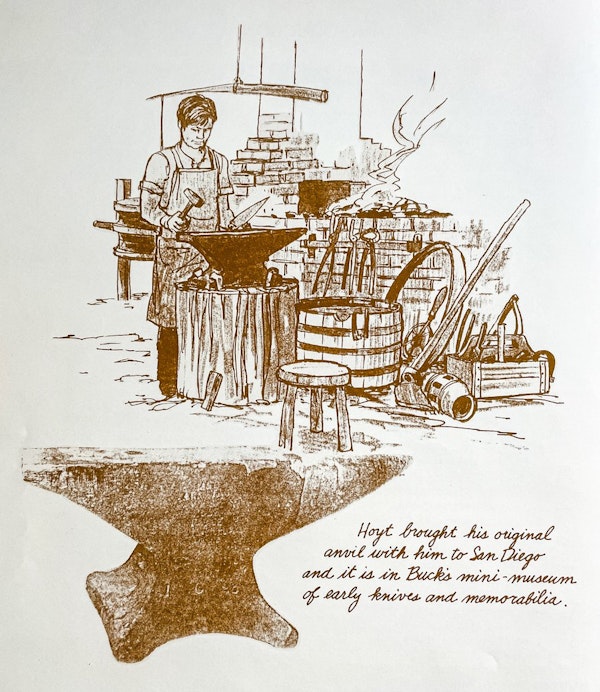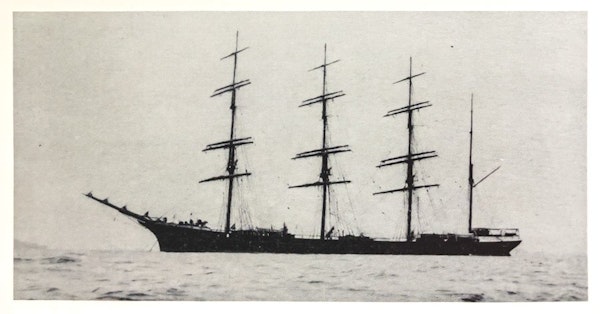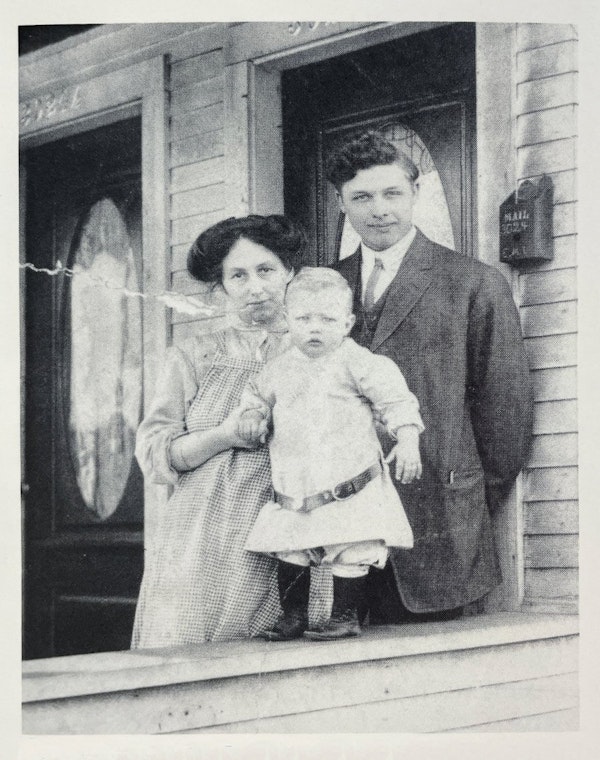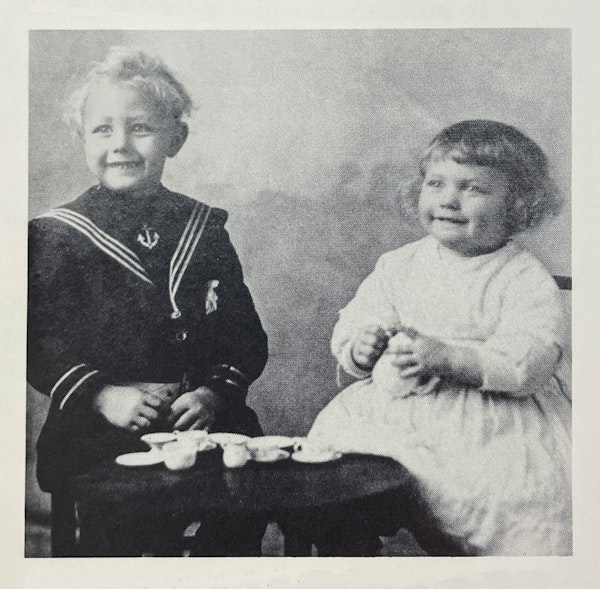Our story, the story of Buck Knives is a story of a family that is proud of its roots, and remains dedicated to the same basic precepts that our founder, Hoyt Buck so clearly laid out many years ago.
It all began at the turn of the century when Hoyt, a teenage apprentice blacksmith created his first knife – a knife that led the way to the wide range of knives that proudly bear his name today.
Based on “The Story of Buck Knives… A Family Business”, written by Tom Ables, we’ll unfold our story, a century of Buck family history and business ventures that created our company.

CHAPTER 1: HOYT BUCK AND THE EARLY YEARS
IT ALL BEGAN on the great American prairie at the turn of the century. But the story of Buck Knives is not a clean, straight line from launch to worldwide prominence. It didn’t follow a clearly-charted course, detailed in advance.
Instead, it’s a fascinating story of moves and interruptions, all part of a circuitous path that led to Buck becoming America’s foremost name in knives.
And it all began with the curiosity and the imagination in the fertile mind of a young apprentice blacksmith named Hoyt Heath Buck, in Leavenworth, Kansas.
The year was 1902 and Hoyt, just 13, was already hard at work. Under the watchful eye of the village blacksmith, he had learned to shoe horses. He fixed wagon wheels and repaired the equipment used to harvest wheat.
And he had another responsibility. Farmers in the area came to the little Kansas smithy to have Hoyt sharpen their grub-hoes and reapers, so critical to farm life on the prairie. It seemed to the teenage apprentice that they came back so often that there must be a better way, a way to make the metal hold an edge.
With the basic equipment at hand, and time to work at it, young Hoyt Buck began experimenting with tempering processes which led to a marked improvement in the edge-holding ability of those tools.
In addition to suitable equipment and ample time, Hoyt also had a supply of worn out files and rasps on hand. So he carried his inexact experimentation to the next stage and made knife blades that held an edge.
From those first spontaneous, imaginative efforts came the basic concepts that still are embodied in today’s precise, sophisticated heat–treat and tempering processes used by Buck to create blades that consistently hold their edge. He discovered the secret was to make sure the entire blade was the same temperature when you put it in the quenching oil, and that wasn’t easy. But if he took his time, and worked at it, Hoyt found he could do it, and that eliminated the “dead spots” in the blade.
The same curiosity, the same sense of experimentation that fired Hoyt Buck’s first efforts with steel now led him in other directions.
Born in 1889, near Kansas City, Missouri, Hoyt Buck was the third of six children. He was raised and lived near Leavenworth for his first 18 years. By all accounts, Hoyt Buck was an intriguing young man who defied easy description.
By formal education standards, he was not well educated because he quit school after the fourth grade. But he was a voracious reader who taught himself English, history and mathematics, and even some rudimentary Latin and Greek.
And there definitely was wanderlust in this lad. In 1907, still only 18 years old, he read about the business boom being enjoyed in the Pacific Northwest. Sensing opportunities he could not hope to find in Kansas, young Buck tossed aside his blacksmith’s apron, packed his bags and headed for Washington, to start a new life.
In Tacoma, Buck sold insurance, worked as streetcar conductor, and on weekends he helped crew a boat that cruised Puget Sound.
This third job had a dramatic impact on Buck’s life. First, he gained a love for the sea. But more importantly, he gained a love for Daisy Louise Green, a young Seattle socialite whose church group had chartered Buck’s boat for a day-long retreat in 1908.
Their social backgrounds contrasted sharply. Daisy’s father, Alfred Green, had recently retired after a long and distinguished career as captain of the last large English sailing ship, the Wilhelm Tell. The ship catered to royalty, to the incredibly rich and to the outrageously famous, and the Greens had moved smoothly among them. Daisy had accompanied her father all over the world.

And so it came as something of a shock to Daisy’s family and friends when she fell in love with Hoyt Buck.
Not surprisingly, Capt. Green disapproved of the idea of his daughter marrying Hoyt. But in 1909, they wed despite her father’s objections. As a result, she was, in essence, disowned by her family. But their love proved genuine, and the couple held hands and shared their lives for the next 38 years, until Daisy’s death in 1947.
By the summer of 1910, the Buck’s were expecting their first child. Hoyt saw the need for steady income and, like many in the Seattle area, this quest led him into the forests of Western Washington. Lumber was king throughout the Northwest, and Buck’s toughness, perseverance and attention to detail were valued qualities in the sawmills that formed the core of the industry. Eventually, he became a “resawyer,” the man who trimmed large sections of rough lumber into finished planks.

On October 20, 1910, Hoyt and Daisy Buck welcomed the arrival of their first child, to be christened Alfred Charles Buck. The family moved from Tacoma to Everett, Washington, in 1912, and over the next 12 years had six more children. Al was joined by Gladys, Dorothy, George, Roland, Margaret and Walter.

In 1918, the Buck’s saw an opportunity they couldn’t resist. With a $4,000 inheritance that Daisy had received from a wealthy relative in England, the family put $1,000 down on 20 acres of land, including a forest, near Lake Stevens, Washington. The remainder was used to purchase furniture, feed, farm equipment and livestock. Al Buck always remembered those as the happiest days of his young life.
Unfortunately, the financial burden proved too heavy for the young family; the Bucks were unable to keep current with payments and lost the property. Hoyt Buck returned to what he knew best, the sawmills. And Al Buck began looking longingly at the horizon, much as his father had done before him.
About the author: Tom Ables, born and raised in San Diego, CA was a lifelong friend to the Buck family. Well known for his work in publicity and advertising, Buck Knives was a client of his firm, Venture, for many, many years. Tom was very passionate about Buck’s products and the family story, which led to him writing “The Story of Buck Knives…A Family Business” in the late 1980s.
Tom was also a proud Navy veteran and alumnus of San Diego State. He enlisted in the Navy near the end of World War II and served aboard the USS Alabama. Honorably discharged in August of 1946, Buck Knives will forever be grateful for his service, friendship and his dedication to the Buck brand.
The Story of Buck Knives…A Family Business, Published and Copyright © 1991 by Buck Knives, Inc. All rights reserved.




